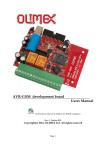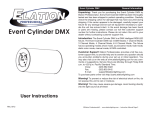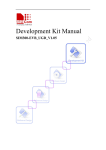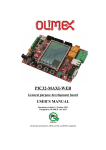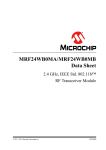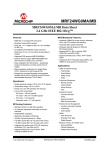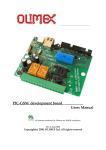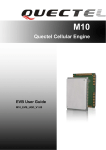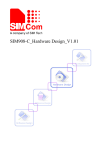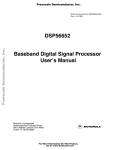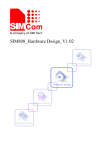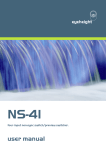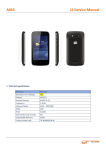Download MOD-GSM development board User`s manual
Transcript
MOD-GSM development board User's manual All boards produced by Olimex are ROHS compliant Rev. E, February 2013 Copyright(c) 2013, OLIMEX Ltd, All rights reserved Page 1 INTRODUCTION MOD-GSM is excellent board for adding remote monitoring and control with the use of the GSM cellular network. With this module you can use all of the the features of each one of Olimex's boards with on-board UEXT connector by GSM network. Also the board can work in stand alone mode, but only when the SIM card is without PIN code. In stand alone mode MOD-GSM don't offer much opportunities. It can receive information by GSM network, but if you want to operate with this information, you will need appropriate board with UEXT connected to MOD-GSM. Choose the other board depending on the application you want to have. MOD-GSM contains quad-band GSM GPRS module 850/900/1800/1900Mhz inside which covers most used GSM networks around the world. The GSM antenna is build in the board so no need for external expensive GSM antennas. BOARD FEATURES • • • • • • • • • • • GSM/GPRS quad-band MODULE 850/900/1800/1900Mhz with build onboard GSM cellular antenna Li-ion backup battery 3.7 V 1200 mAh for up to 200 hours of GSM module stand-by SIM-card holder Status LED On-GSM module temperature sensor UEXT PWR_EXT PWRKEY On-board DC-DC converter for stand alone mode and battery recharge PCB: FR-4, 1 mm (0,039"), solder mask, silkscreen component print Dimensions: 79.2x57.6 mm (3.1182x2.268") ELECTROSTATIC WARNING The MOD-GSM board is shipped in protective anti-static packaging. The board must not be subject to high electrostatic potentials. General practice for working with static sensitive devices should be applied when working with this board. BOARD USE REQUIREMENTS Hardware: 12V, 800mA at least Adapter, if you want to recharge the battery. Some of Olimex boards with UEXT on it. Important: If your board does not work, first try to charge the battery as you power supply the board for few hours. Note that the baud rate it is set on hardware level to 115200. Consider using 115200 when connected to the terminal or host board. Page 2 MODULE FEATURES – Power Supply – single supply voltage 3.4V – 4.5V – Power saving – typical power consumption in SLEEP mode to 2.5mA (BS-PAMFRMS=5) – Charging – Supports charging control for Li-Ion battery – Frequency bands: – SIM340DZ Quad-band: GSM 850, EGSM 900, DCS 1800, PCS 1900. The SIM340DZ can search the 4 frequency bands automatically. The frequency bands also can be set by AT command. – Compliant to GSM Phase 2/2+ – GSM class – Small MS – Transmit Power – – – – – Class 4 (2W) at EGSM 900 – Class 1 (1W) at DCS1800 and PCS 1900 GPRS connectivity – GPRS multi-slot class 8 (optional) – GPRS multi-slot class 10 ( default) – GPRS mobile station class B Temperature range – Normal operation: -20°C to +55°C – Restricted operation: -30°C to -20°C and +55°C to +80°C – Storage temperature -40°C to +80°C DATA GPRS: – GPRS data downlink transfer: max. 85.6 kbps – GPRS data uplink transfer: max. 42.8 kbps – Coding scheme: CS-1, CS-2, CS-3 and CS-4 – SIM340DZ supports the protocols PAP (Password Authentication Protocol) usually used for PPP connections – The SIM340DZ integrates the TCP/IP protocol – Support Packet Switched Broadcast Control Channel (PBCCH) – CSD transmission rates: 2.4, 4.8, 9.6, 14.4 kbps, non-transparent – Unstructured Supplementary Services Data (USSD) support SMS – MT, MO, CB, Text and PDU mode – SMS storage: SIM card – FAX - Group 3 Class 1 – SIM interface - Support SIM card: 1.8V ,3V – External antenna - Connected via 50 Ohm antenna connector or antenna pad Page 3 – – Audio features - Speech codec modes: – Half Rate (ETS 06.20) – Full Rate (ETS 06.10) – Enhanced Full Rate (ETS 06.50/06.60/06.80) – Echo suppression Serial interface and Debug interface – Serial Port: Seven lines on Serial Port Interface – Serial Port can be used for CSD FAX, GPRS service and sending AT command of controlling module. – Auto bauding supports baud rates from 1200 bps to 115200bps. – Debug port: provide two lines on Serial Port Interface /TXD and /RXD – Debug port is only used for debugging – Phonebook management - Support phonebook types: SM, FD, LD, MC, RC, ON, ME,BN,VM,LA,DC,SD – SIM Application Toolkit - Support SAT class 3, GSM 11.14 Release 99 – Real time clock – Implemented – Timer function - Programmable via AT command – Physical characteristics – – Size: 33±0.15 x 33±0.15 x 3±0.3 mm – Weight: 7.8g Firmware upgrade – over serial interface Page 4 SCHEMATIC U1 1 3 MAIN_TX TXD DBG_TX BH10R R27 10K DRX/MRX 1 3 MAIN_RX RXD DBG_RX VBAT MAIN_RX MAIN_TX DTR RTS CTS RI DCD DBG_TX DBG_RX 3 4 43 44 45 11 42 2 1 ANT GSM_PCB_ANT 33 BAT_E 90-DEGREE 1 2 BAT 1 2 3 18 19 20 21 23 24 26 25 TEMP_BAT ANTENNA GND1 GND2 GND3 GND4 GND5 GND6 GND7 GND8 GND9 MIC2P MIC2N MIC1N MIC1P EAR+ RERAUDIOOUT+ AUDIOOUT- AGND 2 VSIM 1 VSIM SIMDATA SIMCLK SIMRST 9 6 7 8 47 +5V TEMP_BAT 15 28 R14 R15 27 29 C18 C19 C20 330pF(NA) 2.2uF(NA) 220nF(NA) 5V_CHG_E 1 NA NA 2 1 0 VCC GND 6 5 4 SIM SIM-HOLDER 4V 2 AUXADC R16 NA PWRKEY 22 C14 47uF/6.3V C15 C17 100nF PWRKEY 1000uF/6.3V/8x12/low_ESR SIM340D 1x3 VBAT 4V_E 1 R5 R4 4.99k/1% VR1 1 6 1N4004(SMD) + PWR 9-12VDC C2 1000uF/16VDC GND C3 2.2uF R2 C4 R1 68k 4.7k 7 4 VIN RT INV SW EN/SYNC GND FB BD9778HFP 5 2 L1 15k/1% C10 10nF(NA) STAT red DCDC_E R6 1 2 0 4.99k/1% R9 560R 15uH/DBS135 3 C5 4.7nF NETLIGHT R3 150k D2 1N5822(SMC) C6 10uF/10V/1206 C7 220uF/10V/tant + D1 + 1 2 100nF TB2_3.5MM +5V 2 NA +12V C21 1nF(NA) NA 38 39 17 30 31 32 34 35 36 37 48 SIMNC VBAT NETLIGHT 41 12 SIMIO SIMRST VBAT TXD CTS DCD PWRKEY 22R 2 1K NA(1K) NA(1K) (NA)1K R13 SIMCLK 1 R22 R23 R24 R25 2 R17 R26 10K 33K 1K NA(3.3K) NA(1K) NA(1K) DTX/MTX SIMRST + R18 R19 R20 R21 2 4 6 8 10 2 RXD RTS DTR RI 1 3 5 7 9 3 C16 220uF/10V/tant UEXT STATUS VSIM GPO1 SIMDATA SPI_DATA SIMCLK SPI_CLK SIMRESET SPI_CS SIM_PRESENCE SPI_D/C KBROW0 BACKUP VCHG RXD TXD TEMP_BAT DTR AUXADC RTS CTS NETLIGHT RI POWERKEY DCD DEBUG_TX VBAT1 DEBUG_RX VBAT2 C13 5 40 14 13 46 16 10 TXD,RXD,RTS,CTS,DTR,DCD,RI,DBG_TX,DBG_RX,MAIN_RX,MAIN_TX 22R OPEN AUXADC CON61.27MM-6-SMALL 22R R12 + +12V R11 SIMCLK + 220 220 R29 R28 VBAT 10uF/10V/1206 1 2 3 4 5 6 10k R10 SIMDATA DOW NLOAD D3 1N5819S PWR_EXT 5V_IN GND VBAT PWR_IN GPIO1 AUXADC VSIM,SIMDATA,SIMCLK,SIMRST +5V MOD-GSM_rev_A1 OLIMEX LTD, BULGARIA, 2013 https://www.olimex.com 1000uF/6.3V/8x12/low_ESR R7 2k C8 1 2 AGND_E ON R8 33k OLIMEX LTD, BULGARIA, 2013 Q1 BC817 BOARD LAYOUT Page 6 POWER SUPPLY CIRCUIT The power supply of MOD-GSM may be done in two ways: 1. Power from +9 - 12VDC without using the external backup battery. In this case the external power supply is used for supplying of 4V to GSM module and thus the module can be powered only from external power supply and the battery must not be connected. In this case the jumpers have to be configured as follows: − jumper BAT_E must be open − jumper 4V_E must be closed − jumper 4V must be closed − jumper 5V_CHG_E must be open. − DCDC_E must be closed Power consumption in this mode is: − near to 70mA when have a conversation. − around 20mA in normal mode (without conversation). Important: 4V_E, 4V and 5V_CHG_E jumpers have to be moved together. 2. Power from +12VDC with external 4.2V Li backup battery. The GSM module is powered always via the battery voltage and the external power supply is used only for charging the battery if it is discharged, i.e. if you have plugged external power supply the battery will be charged and if the board is not powered from external power supply the board will work until the battery dies. In this case the jumpers have to be configured as follows: − jumper BAT_E must be closed − jumper 4V_E must be open − jumper 4V must be open − jumper 5V_CHG_E must be closed − DCDC_E must be closed − Power consumption in this mode: Depends on live of the battery and vary from 260mA to 330mA (fully discharged battery). If we supply the module only via battery, without external power supply, the current through the battery is between 15mA and 30mA if there is no conversation, and between 180mA - 240mA when there is conversation. Page 7 CONNECTOR DESCRIPTIONS JTAG Pin # Signal Name 1 NC 2 GND 3 RXD 4 TXD 5 RTS 6 CTS 7 DTR 8 DCD 9 RI 10 PWRKEY This connector allows connecting to other Olimex boards with UEXT connector. SIM-CARD Pin # Signal Name 1 VSIM 2 SIMRST 3 SIMCLK 4 GND 5 NC 6 SIMDATA This is standard SIM card connector, to operate MOD-GSM should have inserted valid SIM card for your operator network. Page 8 PWR-CON Pin # Signal Name 1 +12V 2 GND This connector is used to power the MOD-GSM. External (+9-12VDC) power source have to be applied to this pins. PWR_EXT Pin # Signal Name Description 1 5V_IN 5V input for battery recharge 2 GND Ground 3 VBAT Output – for power supplying other devices from the GSM battery 4 PWR_IN Optional input for external power supply 5 GPIO1 Doesn't work 6 AUXADC Input for analog signal BAT Pin # Signal Name 1 VBAT 2 TEMP_BAT 3 GND Note: The battery doesn't support TEMP_BAT. Page 9 JUMPER DESCRIPTION BAT_E Connects 3.7V Li-ion battery to the GSM module. Default state is to be open to not drain the battery during stocking the modules. Default state - open 4V_E This jumper is used when power the module without enable 4V to the DCDC output. battery. When connected Default state – open. 4V This jumper is used when power the module without battery. When connected the jumper enable 4V to VBAT power pins of SIM340D module. Default state – open. 5V_CHG_E This jumper is used when the battery is present and allows battery charging. Connects the DCDC converter output (5V or 4V according 4V_E jumper state) to VCHG power pin of SIM340D module. Default state closed Important: 4V_E, 4V and 5V_CHG_E jumpers have to be moved together. Do not plug in external +12V if BAT_E jumper is open! DCDC_E Enable DCDC. Connect DCDC output ((5V or 4V according 4V_E jumper state) to the module. Default state closed Download When the jumper is closed allow SIM340D firmware upgrade. Default state is open DTX/ MTX The DebugTX/MainTX defines whether Debug TX terminal or Main TX terminal of SIM340D module is connected to FT232RL virtual com port driver. Default state is DTX Page 10 DRX /MRX The DebugRX/MainRX define whether Debug RX terminal or Main RX terminal of SIM340D module is connected to FT232RL virtual com port driver. Default state is DRX AGND_E Enable board analog ground. Default state is closed INPUT/OUTPUT PWRKEY button – turns on the MOD-GSM module. You can turn on the SIM340D by driving the PWRKEY to a low level voltage for period time from 500mS to 1S Status LED ( red) with name STAT – indicates the state of SIM340D module. STAT is off state - SIM340D is not running 64ms On/ 800ms Off - SIM340D does not find the network 64ms On/ 3000ms Off - SIM340D find the network 64ms On/ 300ms Off - GPRS communication IMPORTANT NOTE ABOUT THE UEXT The information below is for older revisions of the board. If your board doesn't have the serial resistors mentioned below then there is no need to perform the actions mentioned below! If MOD-GSM doesn't transmit properly data on the UEXT of another Olimex board, it might be because some other boards can interfere with MOD-GSM's signals. If the host board has any signal on the I2C and/or the SPI on the UEXT there is very high chance of erroneous behavior. There are two workarounds: 1. Cut the UEXT cable wires 5,6,7,8,9,10. Only wires 1,2,3,4 (NC, GND, RXD, TXD) should remain. OR 2. Remove resistors R19, R20, R21, R23, R24, R25 Page 11 MECHANICAL DIMENSIONS All measures are in inches. Page 12 AVAILABLE DEMO SOFTWARE - Please check the MOD-GSM web pages (standard edition and battery edition): https://www.olimex.com/Products/Modules/RF/MOD-GSM/ https://www.olimex.com/Products/Modules/RF/MOD-GSM-B/ ORDER CODE MOD-GSM assembled and tested. How to order? You can order directly from our web shop or from any of our distributors. Check our web site https://www.olimex.com/ for more info. List of distributors: https://www.olimex.com/Distributors/ Board revision history Rev. A Rev. A1 - initial release - removed resistors R19, R20, R21, R23, R24, R25 Document revision history Rev. B Rev. C Rev. D Rev. E - edited October 2011 – changes in POWER SUPPLY CIRCUIT – more detailed - added note about the recommended baud rate on page 2 - added important note about UEXT line; various formatting changes - updated schematic and disclaimer Page 13 © 2013 Olimex Ltd. Olimex®, logo and combinations thereof, are registered trademarks of Olimex Ltd. Other product names may be trademarks of others and the rights belong to their respective owners. The information in this document is provided in connection with Olimex products. No license, express or implied or otherwise, to any intellectual property right is granted by this document or in connection with the sale of Olimex products. The hardware schematic is released under the Creative Commons Attribution-Share Alike 3.0 United States License. You may reproduce it for both your own personal use, and for commer cial use. You will have to provide a link to the original creator of the project https://www.olimex.com on any documentation or website. You may also modify the files, but you must then release them as well under the same terms. Credit can be attributed through a link to the creator website: https://www.olimex.com The software is released under GPL. It is possible that the pictures in this manual differ from the latest revision of the board. The product described in this document is subject to continuous development and improvements. All particulars of the product and its use contained in this document are given by OLIMEX in good faith. However all warranties implied or expressed including but not limited to implied warranties of merchantability or fitness for purpose are excluded. This document is intended only to assist the reader in the use of the product. OLIMEX Ltd. shall not be liable for any loss or damage arising from the use of any information in this document or any error or omission in such information or any incorrect use of the product. This evaluation board/kit is intended for use for engineering development, demonstration, or evaluation purposes only and is not considered by OLIMEX to be a finished end-product fit for general consumer use. Persons handling the product must have electronics training and observe good engineering practice standards. As such, the goods being provided are not intended to be complete in terms of required design-, marketing-, and/or manufacturing-related protective considerations, including product safety and environmental measures typically found in end products that incorporate such semiconductor components or circuit boards. Olimex currently deals with a variety of customers for products, and therefore our arrangement with the user is not exclusive. Olimex assumes no liability for applications assistance, customer product design, software performance, or infringement of patents or services described herein. THERE IS NO WARRANTY FOR THE DESIGN MATERIALS AND THE COMPONENTS USED TO CREATE MOD-GSM. THEY ARE CONSIDERED SUITABLE ONLY FOR MOD-GSM. Page 14














